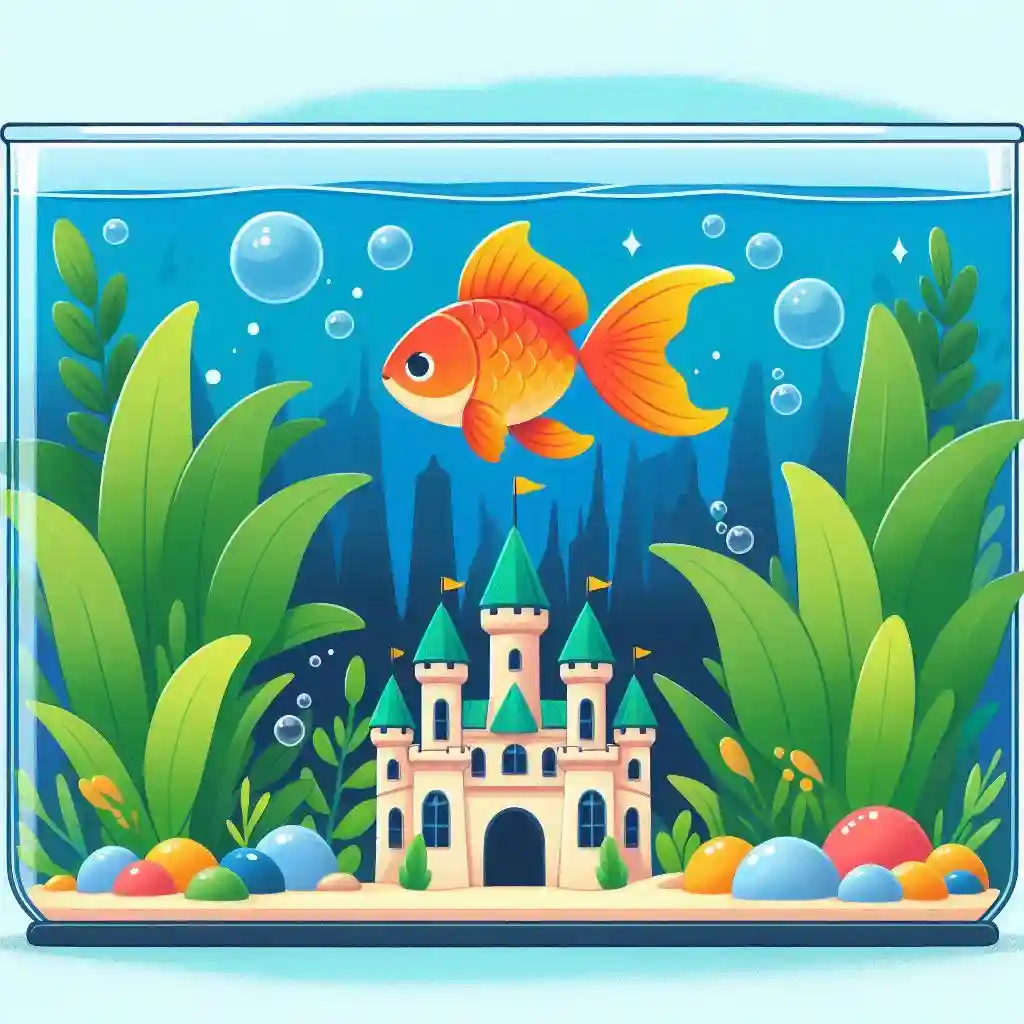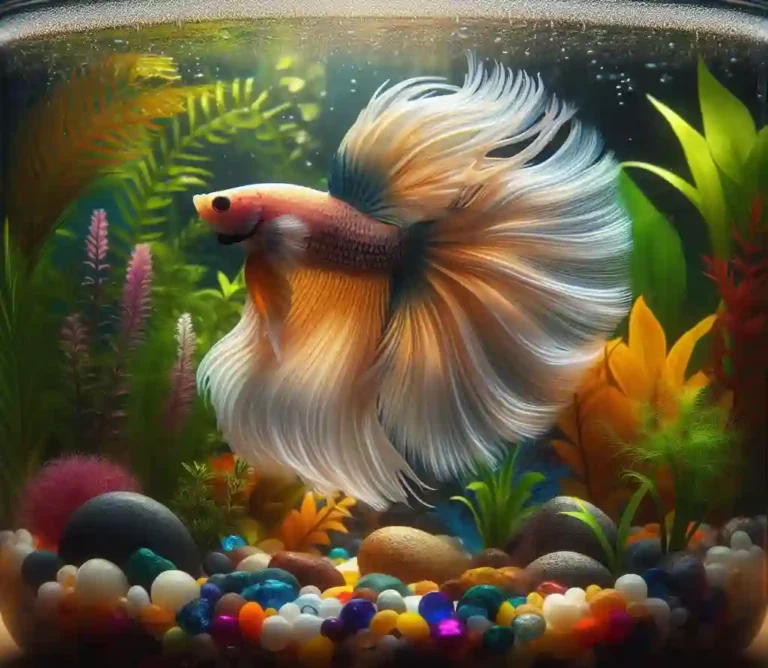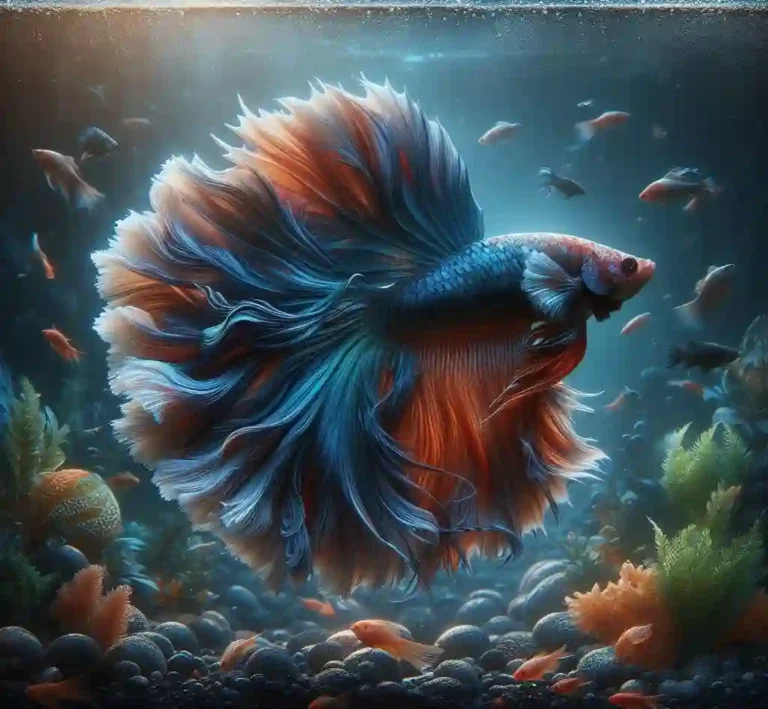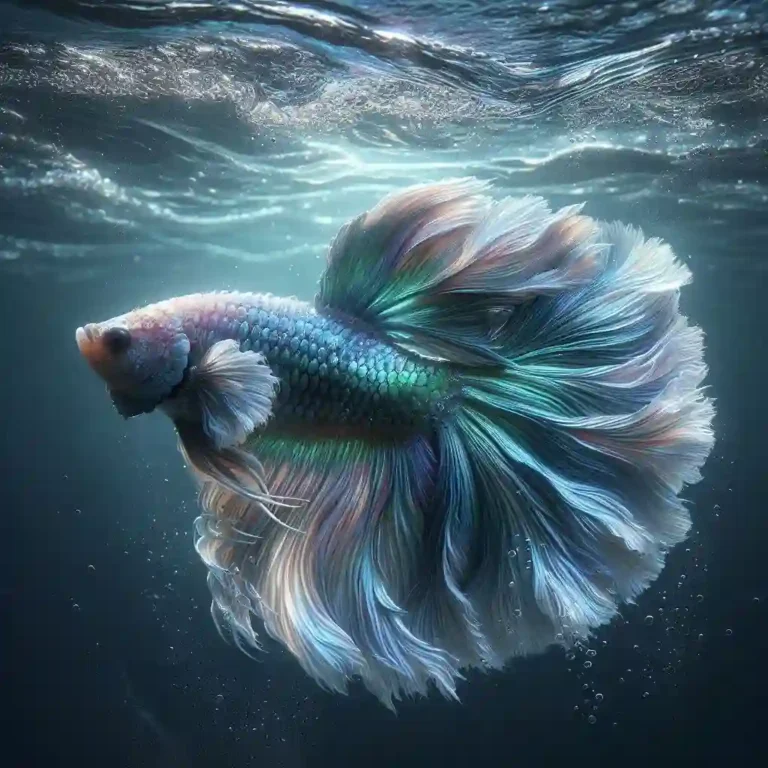Why Do Fish Disappear from Tanks and How to Prevent It?
Fish disappearing from tanks is a common phenomenon that can be both puzzling and distressing for aquarium enthusiasts.
In this guide, we’ll delve into the possible causes of disappearing fish and provide you with actionable tips to identify and address the root of the problem, ensuring a healthy and thriving aquarium for your finned friends.
Fish Disappear from Tanks – A Quick Guide

Possible Causes:
- Predation: If you have multiple species in the same tank, some fish might be predators that feed on smaller fish.
- Hiding or Camouflage: Fish can hide in plants, rocks, or other decorations, making it seem like they’ve disappeared.
- Disease or Injury: Sick or injured fish may hide or become lethargic, leading you to think they’ve vanished.
- Water Quality Issues: Poor water quality can cause fish to stress, leading to illness or death.
- Jumping or Escaping: Some fish, like betta or gouramis, can jump out of the tank or escape through small openings.
- Overfeeding: Excess food can attract pests like snails or other aquatic creatures that might eat your fish.
- Tank Maintenance: Infrequent water changes or inadequate filtration can lead to water quality issues, causing fish to disappear.
Actionable Steps:
- Observe and Inspect: Carefully observe your tank and inspect the decorations, plants, and substrate for hidden fish.
- Check Water Quality: Test the water for ammonia, nitrite, and nitrate levels. Perform a partial water change (25-50%) to improve water quality.
- Quarantine New Fish: Isolate new fish for 2-4 weeks to ensure they’re healthy and free of diseases.
- Monitor Fish Behavior: Watch for signs of stress, disease, or injury, and take action promptly if you notice any issues.
- Secure the Tank: Ensure the tank is securely covered to prevent jumping or escaping fish.
- Adjust Feeding: Monitor food intake and adjust feeding amounts to prevent overfeeding.
- Regular Maintenance: Perform regular water changes, clean the gravel, and maintain good filtration to prevent water quality issues.
Mysterious Disappearance: Ruling Out Jumping Fish
When a fish disappears from a tank, one of the first possibilities that comes to mind is that the fish might have jumped out of the tank. It’s not uncommon for fish to leap out of the water, especially if they’re stressed, frightened, or simply trying to escape predators.
Checking for signs of jumping
- Water splashes or spills: If your fish jumped out of the tank, you might notice water splashes or spills around the tank or on the surrounding floor.
- Fish on the floor: This might seem obvious, but take a close look around the tank and surrounding area to see if your fish is lying on the floor.
- Wet footprints or trails: If your fish jumped out of the tank, it might have left behind a trail of wet footprints or a wet path leading away from the tank.
What to do if you suspect jumping
- Search the surrounding area: Thoroughly search the area around the tank, including any nearby furniture, decorations, or plants.
- Check for hiding spots: Look for any potential hiding spots where your fish might be hiding, such as under furniture, behind decorations, or in nearby containers.
- Set up a makeshift trap: If you’re not sure where your fish might be, set up a makeshift trap using a container filled with water and some food to lure your fish back in.
Tank Inspection: Checking for Hiding Spots and Escape Routes

Checking for hiding spots
- Decorations and ornaments: Check behind, underneath, and inside any decorations, plants, or ornaments in the tank. Fish can hide in tiny crevices or under ledges.
- Rocks and caves: Inspect any rocks, caves, or other structures in the tank for hidden crevices or hiding spots.
- Plants and foliage: Check among the leaves and stems of live plants or artificial foliage for hidden fish.
- Filter and heater compartments: Some fish might hide in the compartments or pipes surrounding the filter or heater.
Checking for escape routes
- Gaps or holes in the tank: Inspect the tank’s walls, floor, and lid for any gaps, holes, or cracks that might allow a fish to escape.
- Loose or damaged tank seals: Check the seals around the tank’s lid, filter, and other equipment to ensure they’re secure and not compromised.
- Unsecured tank decorations: Make sure any decorations or plants are securely anchored to the tank to prevent them from shifting or toppling over, creating an escape route.
What to do if you find a hiding spot or escape route
- Carefully remove the fish: If you find your fish hiding in a decoration or crevice, carefully remove it and return it to a safe area of the tank.
- Repair or replace damaged components: If you find a gap, hole, or damaged seal, repair or replace it to prevent future escapes.
- Rearrange the tank: Consider rearranging the tank’s decorations and layout to reduce hiding spots and escape routes.
Predator Alert: Suspecting Tankmates of Fishnapping

Identifying potential predators
In a community tank, some fish are more likely to be predators than others. Here are some common culprits to suspect:
- Large or aggressive fish: Fish like cichlids, angelfish, or larger species of catfish might see smaller fish as prey.
- Fin-nippers: Fish like tiger barbs, serape tetras, or lemon tetras are known to be fin-nippers and might attack smaller fish.
- Omnivorous fish: Fish like loaches, catfish, or some species of plecos might eat smaller fish, especially if they’re hungry or competing for food.
Signs of fishnapping
If you suspect that one of your tankmates is responsible for the disappearance of your fish, look for these signs:
- Injuries or wounds: Inspect the remaining fish for signs of injury, such as torn fins, scales, or bite marks.
- Aggressive behavior: Observe the behavior of your fish, especially during feeding times. If you notice aggressive behavior, such as chasing or nipping, it might indicate a predator-prey relationship.
- Unexplained changes in appetite: If a fish is eating more than usual or showing unusual interest in food, it might be a sign that it’s been feeding on smaller fish.
What to do if you suspect fishnapping
If you suspect that one of your tankmates is responsible for the disappearance of your fish, here are some steps to take:
- Separate the suspected predator: Immediately remove the suspected predator from the tank and quarantine it to prevent further attacks.
- Monitor the remaining fish: Keep a close eye on the remaining fish for signs of stress, injury, or aggression.
- Reassess your tank’s compatibility: Consider rearranging your tank’s inhabitants to ensure compatibility and reduce aggression.
Water Quality Crisis: Could Toxicity Be to Blame?
The hidden dangers of water quality issues
Water quality issues can arise from various sources, including:
- Poor tank maintenance: Infrequent water changes, inadequate filtration, or neglecting to clean the gravel can lead to toxic buildup.
- Overfeeding: Excess food can decay and release ammonia, nitrite, and nitrate, which can be toxic to fish.
- Inadequate cycling: A tank that’s not fully cycled can lead to ammonia and nitrite spikes, which can be lethal to fish.
Signs of water quality issues
If you suspect that water quality issues might be responsible for your fish’s disappearance, look for these signs:
- Cloudy or murky water: If the water is cloudy, murky, or has a strong odor, it might indicate poor water quality.
- Fish gasping or lethargy: If your fish are gasping at the surface, lethargic, or showing labored breathing, it could be a sign of water quality issues.
- Unusual algae growth: Excessive algae growth can indicate an imbalance in the tank’s ecosystem.
Testing and correcting water quality issues
- Ammonia: A toxic compound that can be lethal to fish in high concentrations.
- Nitrite: A toxic compound that can cause stress and illness in fish.
- Nitrate: A byproduct of the nitrogen cycle that can contribute to algae growth and water quality issues.
If you detect any of these toxins, take immediate action to correct the issue:
- Perform a partial water change: Replace 25-50% of the tank water with fresh, dechlorinated water to dilute the toxins.
- Adjust your tank’s maintenance routine: Increase the frequency of water changes, clean the gravel regularly, and ensure adequate filtration.
- Monitor water parameters: Regularly test the water for ammonia, nitrite, and nitrate to ensure the tank is stable and safe for your fish.
Filter Fiasco: Could Equipment Failure Be the Culprit?
The importance of filter maintenance
A filter is the heart of an aquarium, responsible for removing waste, excess food, and decaying matter from the water. However, if the filter is not properly maintained, it can become clogged, reducing its effectiveness and leading to water quality issues.
Signs of filter failure
If you suspect that filter failure might be responsible for your fish’s disappearance, look for these signs:
- Reduced water flow: If the filter is not producing the usual water flow, it might indicate a blockage or malfunction.
- Dirty or clogged filter media: If the filter media is dirty or clogged, it can reduce the filter’s effectiveness and lead to water quality issues.
- Increased ammonia or nitrite levels: If the filter is not removing waste and toxins effectively, it can lead to increased ammonia and nitrite levels, which can be toxic to fish.
Other equipment failures to consider
While filter failure is a common issue, other equipment failures can also contribute to a fish’s disappearance:
- Heater failure: A malfunctioning heater can cause sudden changes in water temperature, which can stress or kill fish.
- Pump failure: A failed pump can reduce water circulation, leading to stagnant water and poor water quality.
- Lighting issues: Incorrect or malfunctioning lighting can disrupt the tank’s natural day-night cycle, causing stress and behavioral changes in fish.
What to do if you suspect equipment failure
If you suspect that equipment failure might be responsible for your fish’s disappearance, take immediate action:
- Inspect and clean the filter: Check the filter for blockages, clean or replace the media, and ensure proper function.
- Check other equipment: Inspect the heater, pump, and lighting to ensure they’re functioning correctly.
- Perform a water change: Perform a partial water change to remove any built-up toxins and stabilize the tank’s ecosystem.
The Great Escape: Investigating Tank Lid and Cover Security
The importance of tank lid and cover security
A secure tank lid and cover are crucial for preventing fish from escaping and maintaining a healthy environment. A loose or damaged lid can:
- Allow fish to jump out: Fish can jump out of the tank if the lid is not securely fastened, leading to injury or death.
- Create an escape route: A damaged or faulty cover can create an opening for fish to swim out of the tank.
- Compromise water quality: A loose or damaged lid can allow contaminants to enter the tank, affecting water quality and fish health.
Inspecting the tank lid and cover
To investigate tank lid and cover security, follow these steps:
- Inspect the lid: Check the lid for any signs of damage, rust, or corrosion. Ensure it is securely fastened to the tank.
- Check the cover: Inspect the cover for any signs of damage, cracks, or holes. Ensure it is securely attached to the tank.
- Look for gaps or openings: Check the tank’s edges, corners, and seams for any gaps or openings that could allow fish to escape.
Securing the tank lid and cover
To prevent future escapes, take the following steps:
- Tighten the lid: Ensure the lid is securely fastened to the tank, and consider adding additional security measures, such as clips or latches.
- Repair or replace the cover: If the cover is damaged, repair or replace it to prevent escape routes.
- Seal any gaps or openings: Use a suitable sealant or adhesive to fill any gaps or openings around the tank’s edges, corners, and seams.
Disease and Death: The Unsettling Possibility of Fish Demise
Common fish diseases
Some common fish diseases that can affect aquarium fish include:
- Bacterial infections: Bacterial infections can cause a range of symptoms, including labored breathing, lethargy, and changes in appetite.
- Fungal infections: Fungal infections can cause skin lesions, fin rot, and other symptoms.
- Parasitic infections: Parasites like ich, velvet, and anchor worms can cause a range of symptoms, including labored breathing, lethargy, and changes in appetite.
Signs of disease
- Labored breathing: If your fish are having trouble breathing, it could be a sign of respiratory disease.
- Lethargy: If your fish are lethargic or showing little interest in food, it could be a sign of illness.
- Changes in appetite: If your fish are not eating or showing a decrease in appetite, it could be a sign of illness.
- Changes in color or appearance: If your fish are showing changes in color, fin damage, or other physical changes, it could be a sign of disease.
What to do if you suspect disease
- Quarantine the tank: Quarantine the tank to prevent the spread of disease to other fish.
- Treat the tank: Treat the tank with a suitable medication to address the suspected disease.
- Monitor the tank: Monitor the tank closely for any signs of disease or illness.
- Consult a veterinarian: If you’re unsure about the cause of your fish’s disappearance or how to treat the tank, consult a veterinarian or experienced aquarist for guidance.
The Hunt for Clues: Conducting a Thorough Tank Investigation
Gathering clues
- Observe the tank: Observe the tank carefully, looking for any signs of disturbance, such as ripples in the water or changes in the tank’s environment.
- Check the tank’s environment: Check the tank’s environment for any changes, such as changes in water temperature, pH, or water hardness.
- Inspect the tank’s inhabitants: Inspect the tank’s inhabitants for any signs of stress, injury, or illness.
- Check the tank’s equipment: Check the tank’s equipment, such as the filter, heater, and pump, for any signs of malfunction or damage.
- Check the tank’s decorations: Check the tank’s decorations, such as plants, rocks, and ornaments, for any signs of damage or disturbance.
Analyzing the tank’s environment
- Water quality: Check the tank’s water quality, including pH, ammonia, nitrite, and nitrate levels.
- Water temperature: Check the tank’s water temperature to ensure it is within a suitable range for the fish.
- Water hardness: Check the tank’s water hardness to ensure it is suitable for the fish.
- Tank size and layout: Check the tank’s size and layout to ensure it is suitable for the fish.
Considering various factors
- Fish behavior: Observe the fish’s behavior to determine if they are stressed, injured, or ill.
- Tankmates: Consider the possibility that tankmates might be responsible for the disappearance.
- Equipment failure: Consider the possibility that equipment failure might have contributed to the disappearance.
- Water quality issues: Consider the possibility that water quality issues might have contributed to the disappearance.
FAQs
Q: Why do fish disappear from tanks?
A: Fish can disappear from tanks due to various reasons, including predation, hiding, disease, injury, water quality issues, jumping or escaping, and overfeeding.
Q: How can I prevent fish from disappearing?
A: Regularly monitor water quality, perform partial water changes, maintain good filtration, and ensure a balanced and nutritious diet. Also, introduce compatible species, provide adequate hiding places, and secure the tank to prevent jumping or escaping.
Q: What are the signs of a sick or stressed fish?
A: Look for signs such as labored breathing, lethargy, loss of appetite, erratic swimming, or visible injuries. If you notice any of these signs, isolate the affected fish and provide proper treatment.
Q: Can I prevent fish from jumping out of the tank?
A: Yes, by ensuring the tank is securely covered, using a tight-fitting lid, and placing a mesh or screen over the top of the tank. You can also reduce water surface agitation and provide plenty of hiding places to reduce stress.
Q: How often should I perform water changes?
A: Perform partial water changes (25-50%) every 1-2 weeks to maintain good water quality and prevent the buildup of toxins.
Q: What should I do if I suspect predation?
A: Observe your fish behavior, and if you suspect predation, separate the aggressive species or provide plenty of hiding places and visual barriers to reduce aggression.
Q: Can I overfeed my fish?
A: Yes, overfeeding can lead to water quality issues and attract pests that might eat your fish. Monitor food intake, and only provide what your fish can consume within a few minutes.
Q: How can I ensure compatibility among fish species?
A: Research the specific needs and temperaments of each species, and introduce compatible fish that thrive in similar water conditions.

Hello, I’m Aria Cooper, the heart and soul behind Swimmy Buddies. As a devoted fish aficionado, I share my aquatic adventures and expertise to inspire your own underwater explorations. 🐠🌊







